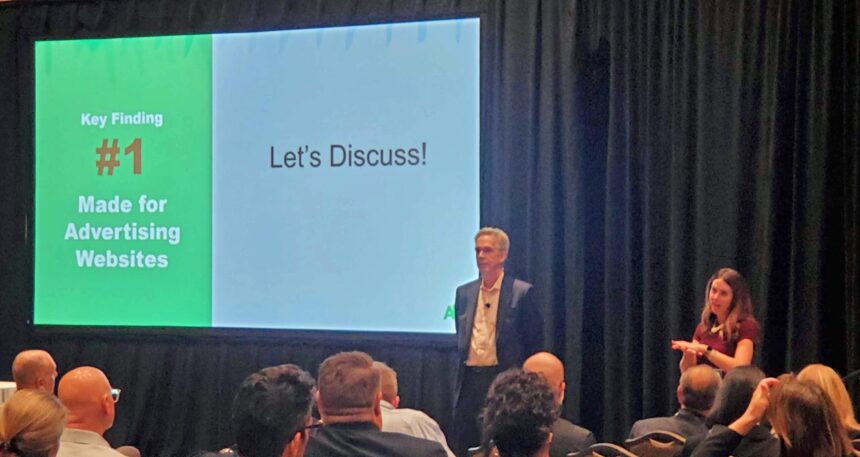Any brand can erase MFA from its programmatic spend – if it wants to.
That’s according to the ANA and TAG TrustNet’s second quarterly Programmatic Media Transparency Benchmark report. The ANA previewed the report, which is set to be released in November, at its Masters of Marketing event in Orlando, Fla., on Thursday.
By implementing the anti-MFA playbook detailed in the report, brands were able to reduce the portion of their programmatic budgets going to made-for-advertising sites to about 1%. That’s down from 4% in the previously released June benchmark report.
Based on these findings, the ANA has created a curriculum for its members on avoiding MFA sites and other programmatic waste, in partnership with Scott Cunningham, the founder and former GM of the IAB Tech Lab.
ANA Group EVP Bill Duggan previewed the report and the anti-MFA framework alongside Mercedes Ritchey, senior director of brand media strategy for Discover Financial Services, one of 21 brands that participated in the report.
The MFA problem
Advertisers have come a long way since the ANA first put the MFA problem on the industry’s map in its June 2023 Programmatic Transparency Report. At the time, the ANA found that 15% of brand budgets – about $13 billion annually – went to MFA sites, which were cluttered with banners and sticky videos that had little impact on campaign results.
MFA sites also draw mostly paid traffic, with audiences that arrived at the page after clicking a link in a native content chumbox.
“I’ve been known to click on some of those previously as a consumer – sometimes, you want to see what Princess Kate wore today,” Ritchey said. But you “don’t necessarily want to be next to it as an advertiser.”
Brands weren’t aware of how much they were really spending on these sites, or even what they were, before last year, Duggan said.
That lack of awareness let bidding algorithms spin out of control as buyers chased MFA’s cheap CPMs – which tend to be about 25% lower than non-MFA sites – and strong marks for viewability, video completion rate and invalid traffic, Duggan said.
Subscribe
AdExchanger Daily
Get our editors’ roundup delivered to your inbox every weekday.
The percentage of programmatic spend that originally went to MFA sites among the 21 participants in the November report ranged between “almost nothing and 42%,” he said.
Discover was “definitely above average on that one – not in a good way,” Ritchey said. “But it was an opportunity for us to learn and get better.”
As a result of Discover following the ANA playbook, as well as implementing DoubleVerify’s anti-MFA solution, it reduced its MFA spend by 99%, she said.
Here’s how Discover followed the ANA playbook:
Step 1: Buy from fewer sites
Lowering the number of sites it’s buying ads from is one of the biggest changes an advertiser can make in avoiding MFA, as well as increasing the overall efficiency of its programmatic campaigns.
Advertisers can easily find out how many sites they’re buying from by requesting a report from their DSPs, Duggan said, then pare that list down to reliable publishers.
In the June benchmark report, advertisers bought from 44,000 websites on average. That number was cut in half in the November report, Duggan said.
Discover now buys from between 9,000 and 10,000 sites, Ritchey said. And it’s in constant communication with its agency partners about whether that is the “right 10,000 websites, and how do we continue to streamline.”
Step 2: Use inclusion lists
Ritchey added that advertisers need to be just as responsible as their agencies for vetting what publishers they’re buying from.
To help weed MFA sites from their campaigns, Duggan recommended using Jounce Media’s and DeepSee.io’s lists of known MFA sites. “By now, every agency holding company has these lists,” he said. “Demand that MFA websites be excluded from a media buy, unless you specifically want them.”
But advertisers should use these MFA site lists to create inclusion lists of trusted sites, rather than playing Whac-A-Mole with exclusion lists, Duggan said. Plus, generative AI will make it even easier for bad actors to constantly create new MFA sites and avoid exclusion lists, he added.
Discover has switched to using an inclusion list, which it updates quarterly, Ritchey said. It’s working toward the ANA recommendation of updating its list monthly.
Step 3: Work with fewer SSPs
Brands should also cut the number of SSPs they’ve integrated because it’s easier for MFA to sneak into convoluted supply chains that are heavy on reselling.
Back in the ANA’s June 2023 report, it found participating brands worked with 19 SSPs on average for programmatic campaigns of at least $5 million – with one brand integrating 53 SSPs. That’s a far cry from Jounce Media’s recommended count of five to seven, Duggan said.
Discover currently works with 11, Ritchey said, and is trying to trim that down to seven.
Not only has that consolidation helped bring down Discover’s MFA spend, she said. It also made its programmatic business more environmentally friendly. The November report found MFA activity has a 26% higher carbon footprint than non-MFA activity.
Step 4: Get down to the log level
Advertisers also need to fight the information asymmetry between themselves and sellers, Duggan said. “Programmatic sellers typically have more or better information than buyers about the quality [of media].”
To combat that asymmetry, brands should make sure they’re getting log-level data on their buys from the ad tech vendors across their supply chain, including DSPs, ad servers, verification vendors and SSPs, said Tim Brown, co-founder of Fiducia. This company helped design the ANA’s TrueKPI framework for assessing media quality.
To ensure they’re getting this log-level data, brands should reassess their existing contracts and stipulate that their partners provide it, Duggan said.
Brands should also make sure their contracts with agency partners clearly reflect their media-buying preferences and whether the agency is acting as a principal buyer that resells media, he said. “Increasingly, media agencies are now principals” that recommend buying cheap resold inventory because they can collect a higher margin from the brand’s budget, he added.
For its part, Discover has expanded its media strategy and activation team, as well as its stewardship and governance teams, to 12 people overall, Ritchey said. And it’s working more closely with its agency of record, Mindshare, to ensure all of its partners and contracts are on the up and up.
“It does take manpower in order to start peeling back the onion and learning about these things,” she said, “and to even make sure you have the right visibility in place.”




























